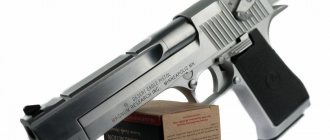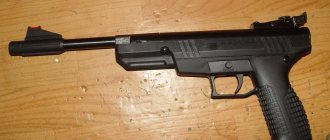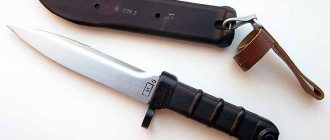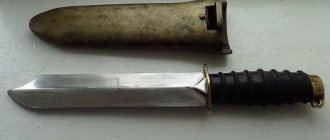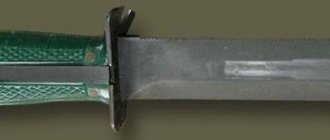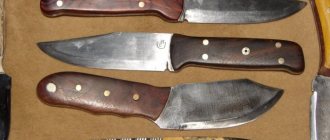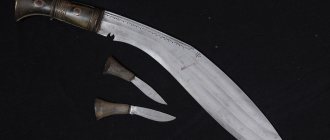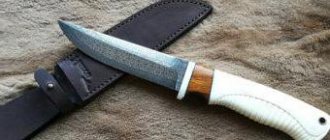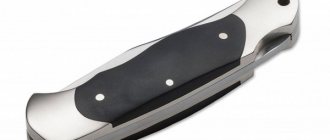Which sheath is best to choose for a knife?
You will have to decide how the knife will be oriented in the sheath, or rather, which direction the blade will face, since this determines what position the knife will be in the hand after it is removed and how it will need to be deployed.
In the event that the knife is held with a direct grip, provided that the knife is oriented inward, namely: its blade is facing the thumb, while the butt is facing the index finger, then in this case it is especially convenient to cut towards oneself, for example, peel potatoes, apply ripping blows from bottom to top or planing wood. With such blows they usually cut the throat of a sentry, carefully approaching him from behind and remaining unnoticed by him.
If the blade of the knife is directed outward, namely towards the index finger, while the butt is directed towards the thumb, then in this case actions are performed in which the main part of the movements is done from oneself. Usually these are actions of a domestic nature. This is how bread or sausage for sandwiches is cut.
The reverse grip can be used in self-defense by holding the knife with the blade facing outward. Thus, the knife is hidden behind the hand. It will only come out at the very last moment, when the distance between the opponents becomes critical and it is possible to inflict a serious, powerful cut. In the event that a high force ripping cut is required, for example, when you need to cut a thick bag, and the knife is not too sharp, then it is best to turn its blade inward, since the knife first sticks in and then pulls towards itself. Thus, you will not have to put in as much effort as if you were pushing the knife away from you.
Again I would like to talk about the scabbard, which was made for many centuries from leather, wood or metal. In wartime, they preferred to use cheaper materials, such as tarpaulin. Currently, scabbards made of plastic or not entirely plastic, but with synthetic inserts, are becoming increasingly popular.
If the sheath is made correctly and looks aesthetically pleasing, it probably has a high coefficient of friction. The blade is held securely in them and does not dangle. At the same time, leather has a number of disadvantages: it deteriorates from water and is susceptible to the negative effects of microorganisms. In this regard, leather sheaths are not recommended for people forced to live in tropical latitudes or in constant contact of equipment with water, as is the case with fishermen. If the leather is of insufficient quality, it will very quickly become completely unsuitable for use: it will warp, lose its shape, and stretch. It must be said that leather is inherently a very conservative and expensive material.
If the sheath is made of leather, then it can come into contact with a handle made exclusively of materials such as wood or birch bark, that is, of natural origin. Actually, even from an aesthetic point of view, it would be wrong to keep a knife with a high-tech plastic handle in a leather sheath. It would look, to say the least, unnatural.
Modern sheaths are often made of synthetic fabric with a plastic liner. They are sewn in the same way as leather ones. At the same time, synthetics have a number of advantages: this material is not as demanding as leather in operation; it does not rot or warp, and practically does not lose its shape, although it naturally wears out much faster than leather. Synthetics can serve well for a long time thanks to the plastic liner, but quickly lose their attractive appearance. In addition, the blade, which is in a plastic sheath, usually knocks when walking.
Metal sheaths are currently practically not used. Instead, they prefer to make molded sheaths from hard plastic. This type of sheath seems quite interesting, since it is very rigid, and therefore allows you to experiment with a variety of devices for attaching the sheath to the body. With such a sheath, traditional fasteners are not required: they are reliably able to hold the knife in any position.
These sheaths are often supplied with laces, chains, plastic or metal clips for attaching them to clothing. Sometimes special locks are made for attaching the sheath to a belt. We also recommend buying an inexpensive branded bag directly from the manufacturer for transporting a batch of knives if you are selling them. Thus, such a sheath can be suitable for almost all conditions for carrying a knife. They are very flexible and sometimes only conservatives are not happy with them, for example those who are used to carrying knives on their belts and nowhere else.
Source: E. A. Ostanina “Combat knives of the world.”
Read on topic:
Flamberges - flaming blades
About sea dirks
The combat stiletto is a weapon of palace intrigue
What types of knives are there?
Sami knife as a historical heritage of the northern peoples
Finnish knife and its varieties
Characteristics of a hunting knife
You also need to know how to carry a knife correctly
EICKHORN ADVANCED COMBAT KNIFE
Eickhorn Advanced Combat Knife is an advanced combat knife that meets HATO military standards. Meets the needs of the armed forces of Germany, for which it was developed. The knife has a tool for stripping wires and a universal saw. The scabbard is equipped with a device for cutting off wires, a sapphire-coated sharpener, a cord and a drainage hole. Thanks to the presence of several attachment points, the knife can be worn on a combat vest, belt or other equipment with the MOLLE system. The thickness of the blade is 3.6 mm, length – 17.5 cm. The total length of the knife is 35.5 cm, weight is 230 g, weight including sheath is 440 g.
COMBAT KNIVES IN THE US ARMY
10/12/2019
KA-BAR USMC Marine Corps knife, Buck M9 MB army bayonet, KA-BAR TANTO BLACK 600 Special Operations Forces soldier knife, Scuba Max Titanium combat swimmer knife, special Camillus SAF and Mark V ATAS knives.
Classmates
A knife is one of the simplest and at the same time most perfect tools invented by mankind over the entire period of its existence. Starting with a flint or bone knife, man brought to modern times the very idea of a compact and highly efficient cutting tool (in the broadest sense of the term). The areas of application of knives are so numerous that they cannot be enumerated, and their shape, determined by the specialization of the knife, is varied. As a rule, most combat knives have a blade with a length of 150 to 200 mm and a width of 30 to 60 mm, made of high-alloy steels, which implies good cutting properties. The specified length of the blade, in turn, provides deep penetrating wounds, and, taking into account the depth of the location of vital organs in the abdominal cavity and chest, it is guaranteed to cut them even at fairly sharp angles of injection. The above blade width allows you to reduce the sharpening angle due to the possibility of increasing the blade sharpening width.
When describing combat knives, special terminology is used: 1. Butt.
2. Fuller - a recess (sometimes through) in the blade of a bladed weapon. Serves for precise adjustment of the balance and removal of “excess” metal to reduce the weight of the entire structure. 3. Guard - a transverse metal plate located at the base of the knife handle; sometimes it is integrated into the handle, sometimes it is formed by expanding the false blade (the so-called shoulders). Serves to prevent the finger closest to the blade from slipping onto the cutting edge, in rare cases - by the grip of someone else's blade. 4. False blade - part of the blade near the handle on which the transverse tapering profile is not molded. Elements of the fixation mechanism in the sheath (ratchet teeth, magnet, ball latch) can be placed on the false blade. It usually bears the manufacturer's mark and the knife number. 5. Main cutting edge. 6. Handle. 7. The pommel is a blind nut that holds the handle to the handle of the knife. In knives with a “dead” fit of the blade on the handle (survival, boy scout and tourist knives), it serves as a cover for the pencil case built into the handle. Taking into account the high firepower and technical equipment of a modern fighter, it can be assumed that the expected knife injuries should be similar in severity to injuries from the use of a pistol or other small arms. This is due to the emphasis on the speedy neutralization of the enemy, and not on his guaranteed death due to internal bleeding caused by through wounds with a stiletto with a small-section blade. Combat knives are divided into several types, in particular the army bayonet knife, the knife of the Marine Corps, special operations forces, combat swimmer and special ones. As examples, we can consider these types of combat knives on specific samples that are in service with units of the US Armed Forces. Combat knives in the US Army Marine Corps Knife KA-BAR USMC
Classic dagger knife (“Bowie”) with a fixed blade made of carbon steel with anode passivation. The sharpening of the blade is one and a half sided, not axial along the upper edge. The guard and pommel are steel. The handle is made of leather discs. Leather scabbard with USMC emblem. It is the official memorial knife for the US Marine Corps of World War II. Blade length 178 mm, total 298 mm, weight 320 g.
Army bayonet knife Buck M9 MB
Knife-dagger with a fixed blade made of 420-C steel. The blade has a one-and-a-half sharpening and is strengthened by impact nitriding of the surface. Immediately behind the butt the saw blade is molded. Can be used as a plier when passing barbed wire barriers. The guard has a muzzle ring. Removable polymer leather handle. Modified fiberglass case with metal fasteners and cutters. Developed in 1973 as a standard bayonet for the M16 assault rifle. Modern modifications M9232 and M9235 have plasma-ceramic spraying, which performs anti-reflective and anti-corrosion functions. Blade length 200 mm, total 350 mm, weight 370 g.
Knife for special operations forces soldier KA-BAR TANTO BLACK 600
Knife with a fixed blade made of Sandvik 12C27 steel with plasma-ceramic spraying. The blade is sharpened on one side, the cutting edge is partially serrated. The guard and pommel are made of titanium and have an eyelet for a cord. Cratan handle. Comes with a Kydex sheath. Effective in combat to destroy. Blade length 160 mm, total 302 mm, weight 310 g.
Combat swimmer's knife Scuba Max Titanium
Knife-dagger with a fixed blade made of titanium-beryllium alloy. The sharpening of the blade is one-and-a-half-sided axial, the wavy edge of the blade has a 90-degree sharpening with variable alignment, which increases injury from a piercing blow. There is a sling cutter at the bottom of the blade. The guard is integrated with a removable handle made of reinforced polypropylene and equipped with an eye. The collar is made in the form of a wing nut. The sheath is made of polypropylene and provides crimp fixation of the blade. The knife is made in two modifications: with a chisel-shaped and flowing blade. Blade length 105 mm, total 208 mm, weight 160 g.
Special knife Camillus SAF
Dagger with a fixed blade made of molybdenum-vanadium steel with anodic passivation. The blade is double-edged, with symmetrical sharpening. The shoulders of the guard are integral with the blade. The handle is overhead, made of Valox polycarbonate with isoprene chips. Supplied with a Kevlar sheath with a shin mount. Can be effective as a throwing knife. Blade length 108 mm, total 219 mm, weight 135 g.
Special knife Mark V ATAS
The blade of the knife is made of tool steel grade A-2. The choice of this steel is primarily due to the fact that it provides a balance between the durability of the cutting edge and the impact strength of the blade. Mark V ATAS has a wavy main blade 175 mm long, a sharpened butt to 2/3 of its length, and a modified spear-shaped tip. A distinctive feature of a blade with a similar geometry is its highest cutting performance. The total length of the Mark V ATAC is 327 mm. The knife handle is made of fiberglass reinforced nylon, which ensures impact resistance and non-electrical conductivity; The handle material is resistant to high temperatures and can withstand more than 200° C. The sheath is made of impact-resistant, cut-proof prylon. The design of the sheath is such that it hides the protrusions of the guard, eliminating unwanted snagging. The knife, when inserted into the sheath, is automatically locked. The fixation system operates silently.
When placing a combat knife on a soldier’s equipment, it is usually taken into account that it must not only be well secured, but also be easily accessible; nothing should prevent it from being quickly removed and instantly brought into a combat position. The knife should not interfere with movement and in conditions of forced immobility. These and some other reasons influence the choice of placement of a combat knife in connection with the specifics of the tasks being solved, the peculiarities of combat conditions and personal combat experience. The scope of combat use of a knife in modern conditions is constantly narrowing, but does not disappear completely. The emerging silent weapon provided a solution to many tasks for which a knife had previously been used, but even such a perfect means of combat cannot completely displace it.
Share this post with your friends
Classmates
Source
Admin
PUSH DAGGER
Push Dagger (also known as a poke knife, push dagger, “first knife”) is a short combat knife with a T-shaped handle. It is designed in such a way as to hold it clenched in the fist with the blade forward, usually sticking out between the index and middle fingers. This is a separate type of combat knives, intended for delivering sudden fatal injections rather than for conducting an open fight. The blade is double-edged, in cross section it resembles a flattened diamond. The total length of the Push Dagger from the tip to the end of the handle is 18.5 cm.
BUNDESWEHR ADVANCED COMBAT KNIFE
Bundeswehr Advanced Combat Knife is a new generation multifunctional knife, which is designed to solve military problems. Released in Germany, it is in service with German militarized units. The Bundeswehr combat knife is popular due to its multifunctional design and light weight. The knife can withstand temperatures from –40°C to +80°C, is protected from corrosion, and is resistant to chemical and biological influences. Its total length is 30.5 cm, blade width is 17.5 cm, length including scabbard is 35.5 cm, weight is about 430 g.
BC-41
BC-41 is a combination of a combat dagger and a brass knuckle. Used by British commandos during World War II for close combat and ambushes. This is a very rare combat knife. Its design was developed by Charles Clements, and the knife was made in England. Handle length – about 12 cm. The length of the open part of the blade is about 13 cm. The total length of the knife is about 25 cm. The knuckle handle at its widest point is 12 cm.
